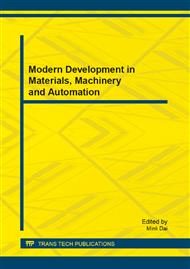[1]
Esaki, L. and Tsu, R: Tunneling in a finite superlattice, Applied Physics Letters, pp.562-564, Jun. (1973).
DOI: 10.1063/1.1654509
Google Scholar
[2]
Horacio I. Cantu, Bruno M. Romeira, Krishna Seunarine, etc. : Conversion of Phase Modulated Signals from Optical Network to Wireless Domain using Resonant Tunneling Diode Optoelectronic Integrated Circuits, Optical Fiber Communication Conference, March (2012).
DOI: 10.1364/nfoec.2012.jth2a.19
Google Scholar
[3]
P. See and D. J. Paul: The scaled performance of Si/Si/sub 1-x/Gex resonant tunneling diodes, IEEE Electron Device Letters, v. 22, pp.582-584, Dec. (2001).
DOI: 10.1109/55.974584
Google Scholar
[4]
RyotaIto, Masao Sakuraba and Junichi Murota.: Hole Tunneling Properties in Resonant Tunneling Diodes with Si/Strained Si0. 8Ge0. 2Heterostructures Grown on Si, IEEE SiGe Technology and Device Meeting, pp.1-2, May (2006).
DOI: 10.1109/istdm.2006.246487
Google Scholar
[5]
Wang Wei, Hao Sun, Lingyun Li and Xiaowei Sun: InP-based resonant tunneling diode with high peak-to-valley current ratio for THz application, IRMMW-THz, pp.1-2, Sept. (2012).
DOI: 10.1109/irmmw-thz.2012.6380445
Google Scholar
[6]
Serge Luryi: Frequency limit of double barrier resonant tunneling oscillators, Applied Physics Letters, Vol. 49, pp.94-96, Jul. (1986).
DOI: 10.1063/1.97362
Google Scholar
[7]
J. N. Schulman and H. J. De Santos : Physics-based RTD current-voltage equation, IEEE Electron Device Letters, Vol. 22, pp.220-222, May (1996).
DOI: 10.1109/55.491835
Google Scholar
[8]
A. Sellai, H. Al-Hadhrami, S. AI-Harthy and M. Henini: Resonant tunneling diode circuits using Pspice, Microelectronics journal, Vol. 34, pp.741-745, May-Aug. (2003).
DOI: 10.1016/s0026-2692(03)00116-2
Google Scholar
[9]
Roger Lake and Junjie Yang: A physics based model for the RTD quantum capacitance, IEEE Electron Devices, pp.785-789, March (2003).
DOI: 10.1109/ted.2003.811390
Google Scholar
[10]
Matiss A.: Large-signal analysis and AC modelling of sub micron resonant tunnelling diodes, Microwave Integrated Circuit Conference, pp.207-210, Oct. (2007).
DOI: 10.1109/emicc.2007.4412685
Google Scholar
[11]
Bhattacharya M. andMazumder P.: Convergence issues in resonant tunneling diode circuit simulation, VLSI Design, pp.499-504, (2000).
DOI: 10.1109/icvd.2000.812657
Google Scholar
[12]
Kanaya H., Shibayama H., Sogabe R. Suzuki S. and Asada M.: Fundamental oscillation up to 1. 31 THz in thin-well resonant tunneling diodes, IPRM, pp.106-109, Aug. (2012).
DOI: 10.1109/iciprm.2012.6403331
Google Scholar


